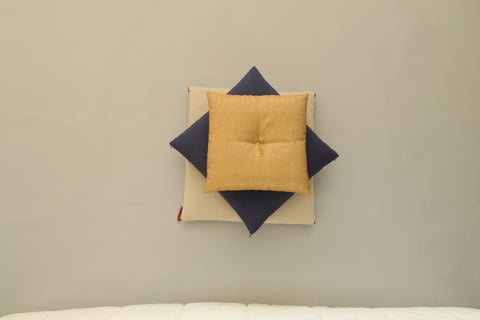Adherence of Craftmanship: Zabuton
Directly translated from the Japanese language, zabuton means cushion for seating. Zabutons were first used in the Kamakura Period (12th ~13th Century A.D.) of Japan. The very first form of zabuton was called a “Shitone”, which was a piece of tatami decorated with fabric. Only the person with the highest status in the room and high ranked monks were allowed to sit on the “shitone”. After that, simplified variations of the “shitone” began to appear. Finally, in the middle of the Edo Period (17th ~ 19th century), people began filling bags with cotton, which later became the prototype of modern zabutons. The use of zabutons allowed people to protect themselves from the cold floor in winter and provide comfort to their bodies while sitting on the floor.


Our adherence for handmade zabutons comes with reasons. To present the best form of zabuton to our customers, we chose to have them handmade. Mainly there are 4 reasons for the zabutons to be handmade.
1. Fabric Trimming
When the fabric is cut by hand, the cut can be adjusted in accordance with the fabric`s thread count, woven pattern, and other factors. As a result, hand cut fabric can optimize the fabric`s function in multiple aspects.
2. Sew and Seams
Sewing the fabric by hand, with a sewing machine, allows the seam to be adjusted. At the request of the customer, it is possible to reduce the seam line to 1cm.
3. Cotton Filling
By shaping and folding the cotton by hand, we can ensure that all the corners of the zabuton are filled with cotton. In addition, in accordance with the shape of the zabuton, the cotton filling can be adjusted to maximize comfort for the user.
4. Attaching the Tassel
To close off the open end for the cotton filling without the traces of the seams, we hand sew the open end shut. The special and skillful craftsmen tucks the seam lines perfectly away from the eyes. In order to secure and fixate the position of the cotton, a tassel is added to the zabuton. The tension of the tassels are adjusted depending on the cotton filling.
Scrutinizing zabutons from a different lens, the zabuton is a product that has its own temperament. From the beginning of the process, zabuton can be seen as a customized product. Not only to the preference of the customer, but the temperament of the fabric, cotton, and thread. Most importantly, while making the zabutons, the craftsmen always keep in mind on the product usage by the customers. The angle of the indent of the cushion, the length of the tassels, and the volume of the cushion, all play equally important roles. Seeking for the perfect balance between the parts of the zabuton is where experience and thoughtfulness weigh in.
